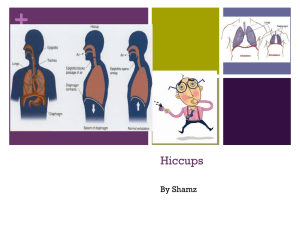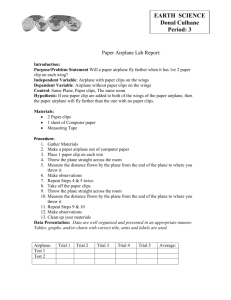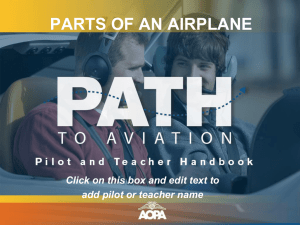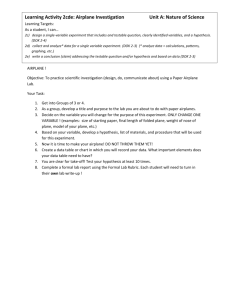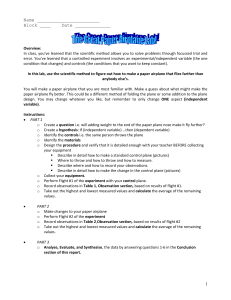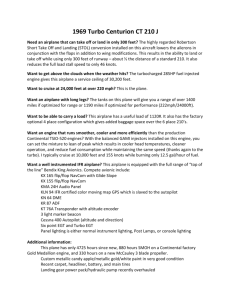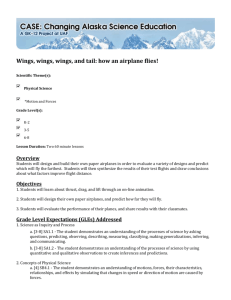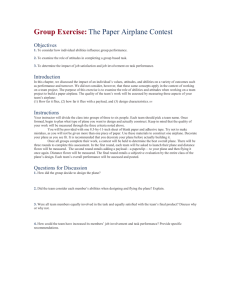Science Trivia Questions - University of Mississippi
advertisement
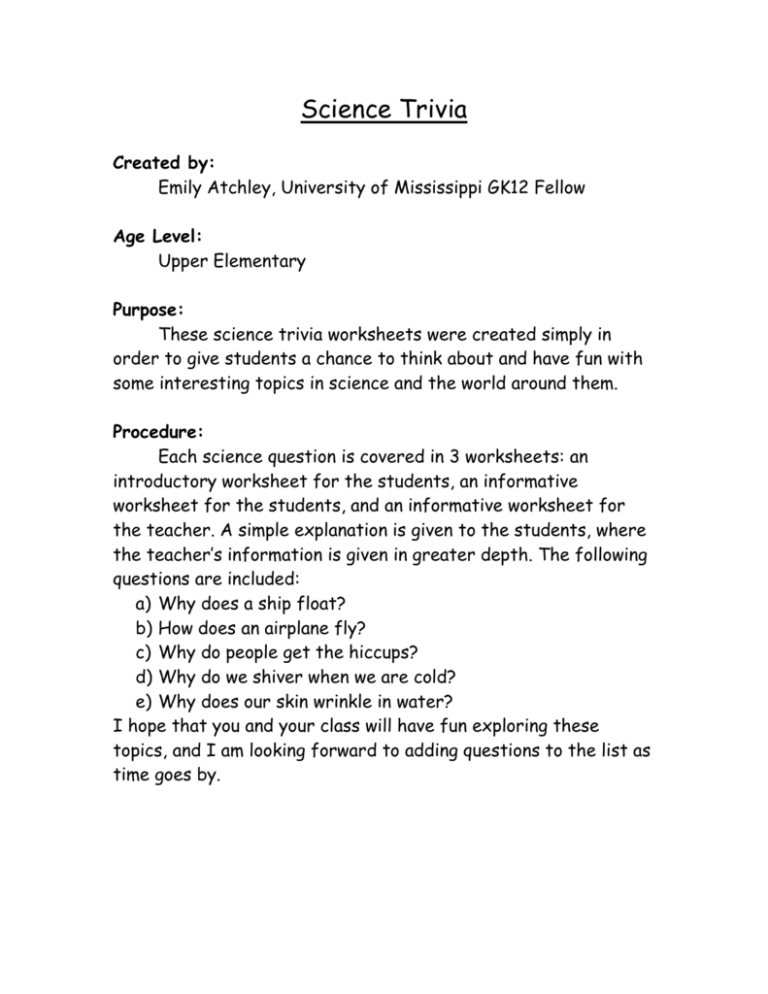
Science Trivia Created by: Emily Atchley, University of Mississippi GK12 Fellow Age Level: Upper Elementary Purpose: These science trivia worksheets were created simply in order to give students a chance to think about and have fun with some interesting topics in science and the world around them. Procedure: Each science question is covered in 3 worksheets: an introductory worksheet for the students, an informative worksheet for the students, and an informative worksheet for the teacher. A simple explanation is given to the students, where the teacher’s information is given in greater depth. The following questions are included: a) Why does a ship float? b) How does an airplane fly? c) Why do people get the hiccups? d) Why do we shiver when we are cold? e) Why does our skin wrinkle in water? I hope that you and your class will have fun exploring these topics, and I am looking forward to adding questions to the list as time goes by. Science Question #1 Q: Why does a ship float? Write your answer in the space below. You may also draw a picture to illustrate your thoughts. Science Question #1 Q: Why does a ship float? A: Water has the ability to keep things afloat. If the force of the water is greater than the force of the ship, then the ship will float. But, the ship will sink if it is too heavy or if it fills up with water. The deck of a ship acts like a cover for the ship. The deck keeps water from coming inside and making the ship too heavy. Science Question #1 For the teacher: It seems quite amazing that a ship made of a heavy material such as steel is indeed able to float. There is an Archimedean principle that enables us to understand how this is possible. Archimedes stated that when an object is immersed in a body of water, it is held up by a force equal to the weight of the water that the object has displaced. The force acting on the object is called buoyancy. Even a very heavy object like metal when shaped like a bowl, for example, will float. The key is that the object must displace enough water so that the buoyancy force acting upon it is greater than the force of its own weight. Of course, if the object fills with water it will sink anyway! Experiment: Using only a big bowl of water and several different objects, you can allow the children to explore the principle of buoyancy for themselves. Find a bowl or a cup that floats and explore what happens when it fills with water. Would a lid for the bowl or cup help to keep water out? Allow time for discovery and discussion. Science Question #2 Q: How does an airplane fly? Write your answer in the space below. You may also draw a picture to illustrate your thoughts. Science Question #2 Q: How does an airplane fly? A: As the plane reaches a high speed, the wind hitting the wings causes a powerful lifting force on the plane. This force lifts the plane upward and makes it fly. The key to flying is the shape of the wings of the airplane. The wings are curved on the top and flat on the bottom. As the wind hits one of the wings, the air on the top has farther to go than the air on the bottom of the wing. This difference causes greater pressure on the bottom of the wing than the top of the wing. Therefore, the pressure on the bottom of the wings lifts the plane up into the air. Pretty amazing! Science Question #2 For the Teacher: The shape of the wing of the airplane is the key to making the airplane fly. Each wing is curved on the top and flat on the bottom. As air hits one of the wings, it is divided into two streams, one above and one below the wing. The air on top has farther to go than the air on the bottom, so it must move faster. The faster air exerts less pressure on the upper surface than the air on the lower surface. This difference is called lift, and the greater the speed of the plane, the greater the lift. Also, in order to maintain enough lift during takeoff and landing the nose of the plane is kept somewhat higher. There are other various wings and flaps that are used by the pilot to keep the plane steady, level, and headed in the right direction. If time permits… Make copies of the “Parts of the Airplane” handout. Spend a few minutes discussing the different functions of the parts of a plane. Are any of the parts unimportant? What would happen if the tail fin, the rudder, or one of the spoilers was missing or broken? Indeed, every part of the airplane has an important job! Science Question #3 Q: Why do people get the hiccups? Write your answer in the space below. You may draw a picture to illustrate your thoughts if you wish. Science Question #3 Q: Why do people get the hiccups? A: A person gets the hiccups when a part of their body called the diaphragm cramps up and begins to twitch violently. The diaphragm is a muscular tissue located under our lungs that helps us to breathe. Sometimes when we swallow something hot or cold, our stomach gets a shock. This shock can cause the diaphragm to twitch, or spasm. Because the diaphragm helps us breathe, when it twitches we cannot help but hiccup! Science Question #3 For the teacher: Q: What makes people get the hiccups? A: A hiccup is caused by the spasmodic contraction of the diaphragm. This spasm, in turn, causes the glottis to snap shut at the moment that we take a breath, which produces the familiar hiccupping noise. Often hiccups begin after a person swallows something hot or cold. The hot or cold shock can cause the diaphragm to begin twitching and, hence, the hiccups. Discussion: Talk with your students about ways that they have tried to rid themselves of the hiccups. You may even take a vote to determine what the class feels is the best method. If time allows, make a graph of the results. Science Question #4 Q: Why do we shiver when we are cold? Write your answer in the space below. You may draw a picture to illustrate your thoughts if you wish. Science Question #4 Q: Why do we shiver when we get cold? A: We feel cold when the temperature of our body goes down. Our muscles shiver and shake in order to make more heat for our body. You can help your body warm up by moving around and exercising. Science Question #4 For the teacher: Q: Why do we shiver when we are cold? A: The human body keeps itself in a stable condition mainly through the autonomic nervous system and the body’s hormones. This stable condition is called homeostasis. The body is usually kept at about 98.6 degrees, regardless of the temperature of the environment. When it is very cold, the body must make more body heat in order to keep itself at the proper temperature. That is why our body causes its muscles to spasm and shiver, producing the heat that we need. Extra Question: Why do we get goose bumps? A: When we get cold, the skin around each hair swells up close to the pore so that as little heat as possible escapes. This contraction of the skin causes the hairs to stand up straight! Science Question #5 Q: Why does our skin wrinkle when we take a bath? Write your answer in the space below. You may draw a picture to illustrate your thoughts if you wish. Science Question #5 Q: Why does our skin wrinkle when we take a bath? A: Our entire body, including our skin, is made up of millions and millions of tiny things called cells. When we take a bath, our skin cells soak up water. The skin on the inside of our hands and the bottom of our feet is thicker than the rest of our skin. Therefore, when these skin cells soak up water, there isn’t room for the swollen cells to lie side by side anymore. So, they are bunched together, causing our skin to wrinkle. Science Question #5 For the teacher: Q: Why does our skin wrinkle when we take a bath? A: The skin on the inside of our hands and the bottom of our feet is thicker than the skin on the rest of our body. When this skin becomes swollen and spongy from being in the water a long time, the skin cells expand and the surface area of the skin increases significantly. The cells become very crowded, and the skin is forced to wrinkle.
